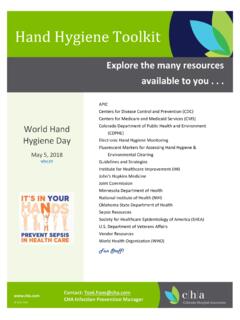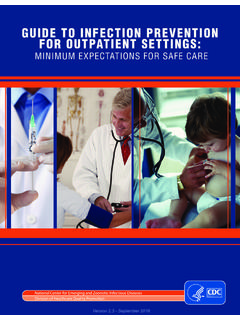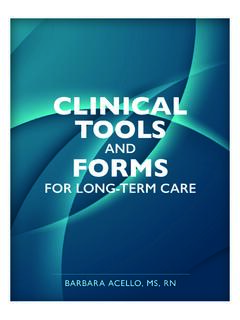Transcription of WATER MANAGEMENT PROGRAM TEMPLATE - CHA
1 WATER MANAGEMENT PROGRAM TEMPLATE . Published: April 2019. Last Updated: April 2019. INTRODUCTION. What is a WATER MANAGEMENT PROGRAM ? Purpose and Use Legionnaires' disease is a serious illness that often results in hospitalization, and sometimes death, of many people throughout the United States every year. In the June 2017 Vital Signs article, CDC stated that 9 out of 10 Legionnaires' disease outbreaks could have been prevented with better WATER MANAGEMENT programs . Over the last few years WATER MANAGEMENT programs have become a prevailing industry standard, with standards like ASHRAE 188 and VA DIR 1061 making headway as reference material. Every type of facility , even those that do not service a high-risk population, could benefit from the implementation of a WATER MANAGEMENT PROGRAM that identifies areas or devices in the building where Legionella might grow or spread to people.
2 This TEMPLATE will help you develop and implement a WATER MANAGEMENT PROGRAM to reduce your facility 's risk for growing and spreading Legionella. How to Use This TEMPLATE Whether you are starting from scratch or looking to improve your existing WATER MANAGEMENT PROGRAM , this TEMPLATE is designed to be a tool for you to use as it fits best to your facility . Creating a WATER MANAGEMENT PROGRAM is never a one-size-fits-all situation, so not all sections of the TEMPLATE will be relevant to your facility . The first thing to know is that if you feel like this is something you may not be able to tackle on your own, review the Selecting a WATER MANAGEMENT Consultant document in Appendix C so you can know how to hire the best consultant to fit your needs. You can also go through CDC's online PreventLD training and CDC's WATER MANAGEMENT PROGRAM Toolkit before you get started on your own TEMPLATE so you have a better idea of how it works.
3 The next step is to work your way through the document, filling out any sections and appendices that are suitable to your facility 's design and maintenance wishes. All of the tables that are included can be edited so you can add/delete rows and columns as you see fit. All of the material presented in the blue boxes is informative or background, while the fillable tables will be below that information. You may also find it beneficial to contact your local or state jurisdiction to identify specific regulations or requirements that will affect the content of your PROGRAM , such as Legionella testing or reporting requirements, cooling tower maintenance requirements, or healthcare facility requirements. Table of Contents Contents Page 1. Legionella and Legionellosis 1. a) Etiologic agent 1. b) Spectrum of clinical disease and risk factors 3. c) Diagnosis and treatment 4.
4 D) National epidemiologic trends 5. e) Case definition 5. 2. WATER MANAGEMENT PROGRAM Title Page 7. 3. facility and WATER MANAGEMENT team 8. 4. Inventory of system components 9. 5. Process flow diagram 12. 6. Environment risk assessment 16. a) System description 16. b) Hazard identification 19. c) Environmental risk MANAGEMENT 20. d) Operational monitoring 21. e) Verification monitoring 22. f) Incident response procedures 23. g) Recreational WATER risk assessment 24. 7. General building 29. a) Construction/ WATER Service Events 30. b) Building Description 31. c) Source WATER Description 31. d) Potable WATER System 32. e) Supplemental disinfection system 34. 8. Multi-unit buildings 35. a) Vacant Room Protocols 35. b) Multi-Unit Building Description 37. 9. Healthcare facilities 38. a) Contact information 38. b) facility Characteristics 39. 10. WATER features 40.
5 A) Recreational WATER facilities 40. b) Heating and cooling equipment ( cooling towers) 46. c) Decorative WATER displays 58. d) Ice machines 60. e) Medical devices ( CPAP, BiPAP, nebulizers) 61. 11. Environmental Sampling and Testing 63. a) WATER sampling 63. b) Sampling supplies checklist 64. c) WATER sampling sites 65. d) Sample data sheet 68. e) Sampling protocols 69. f) Environmental testing 71. 12. Mitigation and Remediation 72. a) Potable WATER Heat and Flush 72. b) Potable WATER Superheating 73. c) Potable WATER Hyperchlorination 74. d) Potable WATER Point-of-Use Filters 75. e) Physical Features Disinfection 75. f) Recreational WATER 76. g) Cooling Towers 77. 13. Appendices a) Glossary of common terms 79. b) Incident report TEMPLATE 82. c) Selecting a WATER MANAGEMENT consultant 83. d) Standards, regulations, and guidance 85. e) Resources 86.
6 F) Contributing agencies 87. g) Acknowledgments 88. Legionella and Legionellosis A. Etiologic Agent Legionellosis (Legionnaires' disease and Pontiac fever) is caused by the Legionella, gram-negative bacteria commonly found in natural freshwater environments ( lakes and streams), most often in warm WATER (77-108 F). Numerous species and subtypes of Legionella have been identified, however Legionella pneumophila serogroup 1 causes approximately 80% of cases of human disease. The bacteria can become a health concern when they grow and spread in human- made building WATER systems. After Legionella grow and multiply in a building WATER system, WATER containing Legionella then has to spread in droplets small enough for people to breathe in. People can get legionellosis when they breathe in small droplets of WATER in the air that contain the bacteria.
7 Less commonly, people can get sick by aspiration of drinking WATER containing Legionella. This happens when WATER accidentally goes into the lungs while drinking ( , goes down the wrong pipe ). Legionella spread from person-to-person is not a meaningful route of transmission. Human-made WATER systems that can transmit Legionella include: Showerheads and sink faucets Cooling towers (structures that contain WATER and a fan as part of centralized air cooling systems for building or industrial processes). Hot tubs that aren't drained after each use Decorative fountains and WATER features Hot WATER tanks and heaters Large plumbing systems Of note, home and car air-conditioning units do not use WATER to cool the air, so they are not a risk for Legionella growth. Legionella tend to grow in biofilms or slime on the surfaces of lakes, rivers and streams, and they are not eradicated by the chlorination used to purify domestic WATER systems (Figure 1).
8 Low and even non-detectable levels of the organism can colonize a WATER source and grow to high concentrations under the right conditions. Figure of pipe containing biofilm and Legionella Image from: WATER conditions that tend to promote the growth of Legionella include: 1. Stagnation, low WATER flow Temperatures between 68 - 122 F (optimal range 95 - 115 F). pH between and Sediment, that can promote growth of commensal microflora Growth of micro-organisms including algae, flavobacteria, and Pseudomonas, which supply essential nutrients for growth of Legionella or harbor the organism (amoebae, protozoa). Figure 2. Legionella in building WATER systems Image from: 2. B. Spectrum of Clinical Disease and Risk Factors Infection with Legionella bacteria can cause three distinct clinical presentations: 1. Legionnaires' disease (Legionella pneumonia).
9 A) Symptoms: fever, myalgias, cough, shortness of breath, clinical or radiographic evidence of pneumonia; associated nausea, vomiting, diarrhea, headache or confusion may be present b) Incubation period: 2 10 days (average 5 6 days). c) Outcome: hospitalization is common; case-fatality rate is 10% (25% for healthcare-associated cases). 2. Pontiac fever a) Symptoms: fever, chills, headache, myalgia, fatigue (NO respiratory symptoms or radiographic evidence of pneumonia). b) Incubation period: 24 72 hours c) Outcome: self-limited illness; case-fatality rate is extremely low 3. Extra-pulmonary infection a) Symptoms: variable, depending on location of infection; myocarditis and pericarditis, sinusitis, septic arthritis, cellulitis and others have all been reported in the medical literature b) Incubation period: variable c) Outcome: variable; extremely rare Most healthy people exposed to Legionella do not get sick.
10 People at increased risk of infection from Legionella include: People 50 years or older Current or former smokers People with a chronic lung disease (like chronic obstructive pulmonary disease or emphysema). People with weak immune systems or who take drugs that weaken the immune system (like after a transplant operation or chemotherapy). People with cancer People with underlying illnesses such as diabetes, kidney failure, or liver failure 3. C. Diagnosis and Treatment Possible laboratory tests to confirm the diagnosis of legionellosis include a positive urine antigen, culture, direct fluorescent antibody (DFA) staining of respiratory samples and tissue, PCR assays of urine, respiratory samples, or blood (Table 1). Serologic tests of antibodies are only diagnostic with a 4-fold or greater rise in antibody titer in paired (acute and convalescent) antibody tests collected 4-8 weeks apart.








